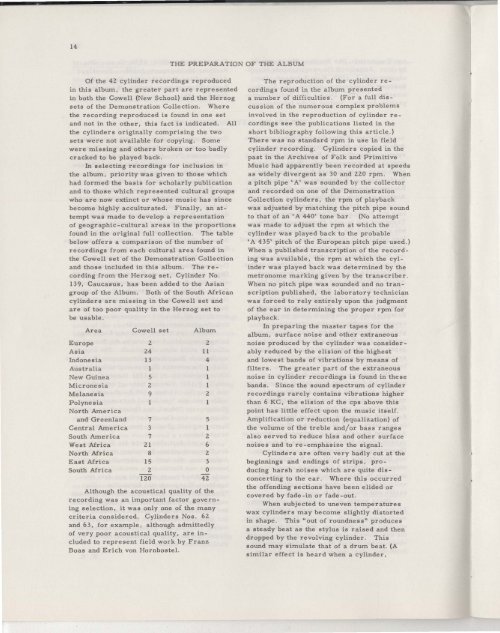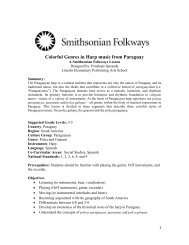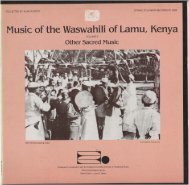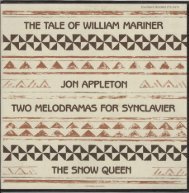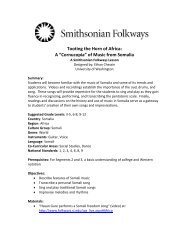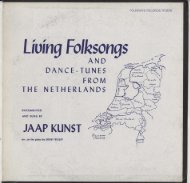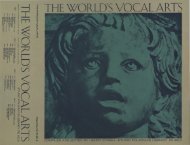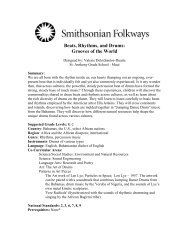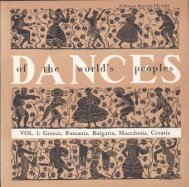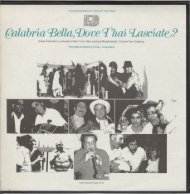FW04175.pdf
FW04175.pdf
FW04175.pdf
Erfolgreiche ePaper selbst erstellen
Machen Sie aus Ihren PDF Publikationen ein blätterbares Flipbook mit unserer einzigartigen Google optimierten e-Paper Software.
14THE PREPARATION OF THE ALBUMOf the 42 cylinder r e cordings reproducedin this album, the greater part are representedin both the Cowell (New School) and the Herzogsets of the Demonstration Collection. Wherethe recording reproduced is found in one setand not in the other, this fact is indicated. Allthe cylinders originally comprising the twosets were not available for copying. Somewere missing and others broken or too badlycr acked to be played back.In selecting recordings for inclusion inthe album, priority was given to those whichhad formed the basis for scholarly publicationand to those which represented cultural groupswho are now extinct or whose music has sincebecome highly acculturated. Finally, an attemptwas made to develop a representationof geographic-cultural are as in the proportionsfound in the original full collection. The tablebelow offers a comparison of the number ofrecordings from each cultural area found inthe Cowell set of the Demonstration Collectionand those included in this album. The recordingfrom the Herzog set, Cylinder No .139, Caucasus, has been added to the Asiangroup of the Album. Both of the South Africancylinders are missing in the Cowell set andare of too poor quality in the Herzog set tobe usable.AreaEuropeAsiaIndonesiaAustraliaNe w Guine aMicronesiaMelanesiaPolynesiaNorth Americaand GreenlandCentral AmericaSouth AmericaWest AfricaNorth AfricaEast AfricaSouth AfricaCowell set2241315291737218152120Album211421512623o42Although the acoustical quality of therecording was an important factor governingselection, it was only one of the manycriteria considere d. Cylinders Nos. 62and 63, for example, although admittedlyof very poor acoustical quality, are includedto represent field work by FranzBoas and Erich von Hornbostel.The reproduction of the cylinder recordingsfound in the album presenteda number of difficultie s. (For a full discussionof the numerous complex problemsinvolved in the reproduction of cylinder recordingssee the publications listed in theshort bibliogr aphy following this article . )There was no standard rpm in use in fieldcylinder recording. Cylinders copied in thepast in the Archives of Folk and PrimitiveMusic had apparently been recorded at speedsas widely divergent as 30 and 220 rpm. Whena pitch pipe 'A' was sounded b y the collectorand recorded on one of the DemonstrationCollection cylinders, the rpm of playbackwas adjusted by matching the pitch pipe soundto that of an 'A 440' tone bar . (No attemptwas made to adjust the rpm at which thecylinder was played back to the probable'A 435' pitch of the European pitch pipe used.)When a published transcription of the recordingwas available, the rpm at which the cylinderwas played back was determined b y themetronome marking given b y the transcriber .When no pitch pipe was sounded and no transcriptionpublished, the laboratory technicianwas forced to rely entirely upon the judgmentof the ear in determini~g the proper rpm forplayba ck.In preparing the master tapes for thealbum, surface noise and other extraneousnoise produced by the cylinder was considerablyreduced b y the elision of the highestand lowest bands of vibrations by means offilters . The greater part of the extraneousnoise in cylinder recordings is found in thesebands . Since the sound spectrum of cylinderrecordings rarely contains vibrations higherthan 6 KC , the elision of the cps above thispoint has little effect upon the music itself.Amplification or reduction (equalization) ofthe volume of the treble and/or bass rangesalso served to reduce hiss and other surfacenoises and to re -emphasize the signal.Cylinders are often very badly cut at thebeginnings and endings of strips , producingharsh noises which are quite disconcertingto the ear. Where this occurredthe offending sections have been elided orcovered by fade-in or fade-out.When subjected to uneven temperatureswax cylinders may become slightly distortedin shape . This "out of roundness" producesa steady beat as the stylus is raised and thendropped by the revolving cylinder . Thissound may simulate that of a drum beat. (Asimilar effect is heard when a cylinder,


